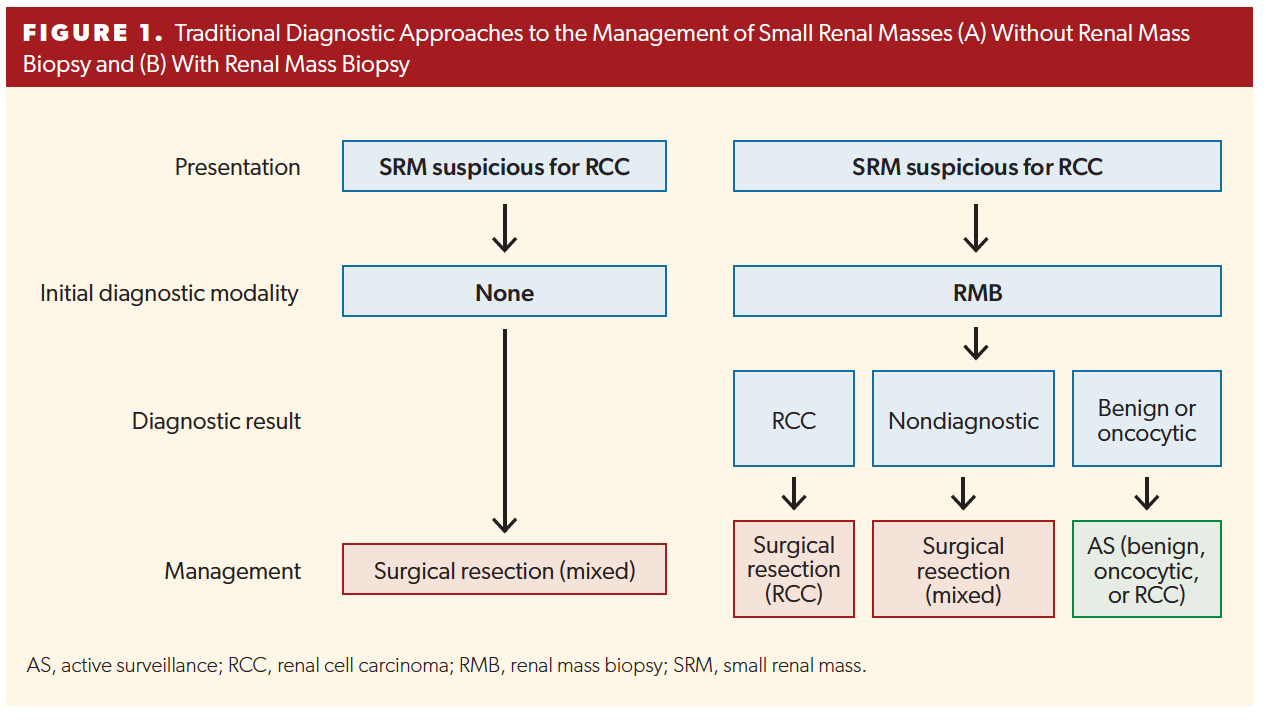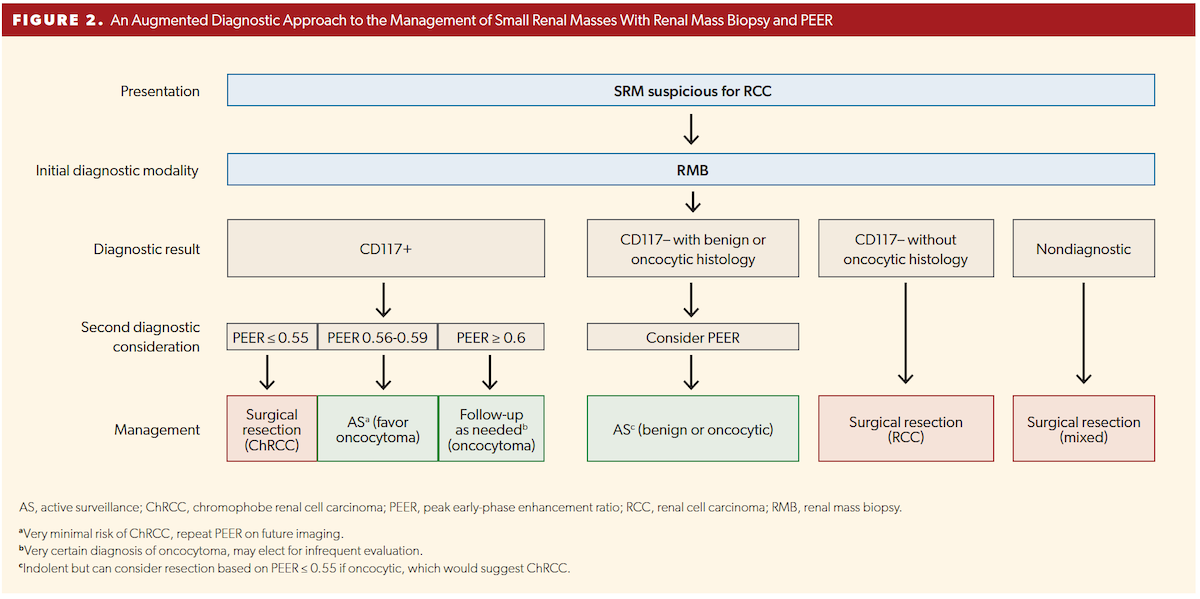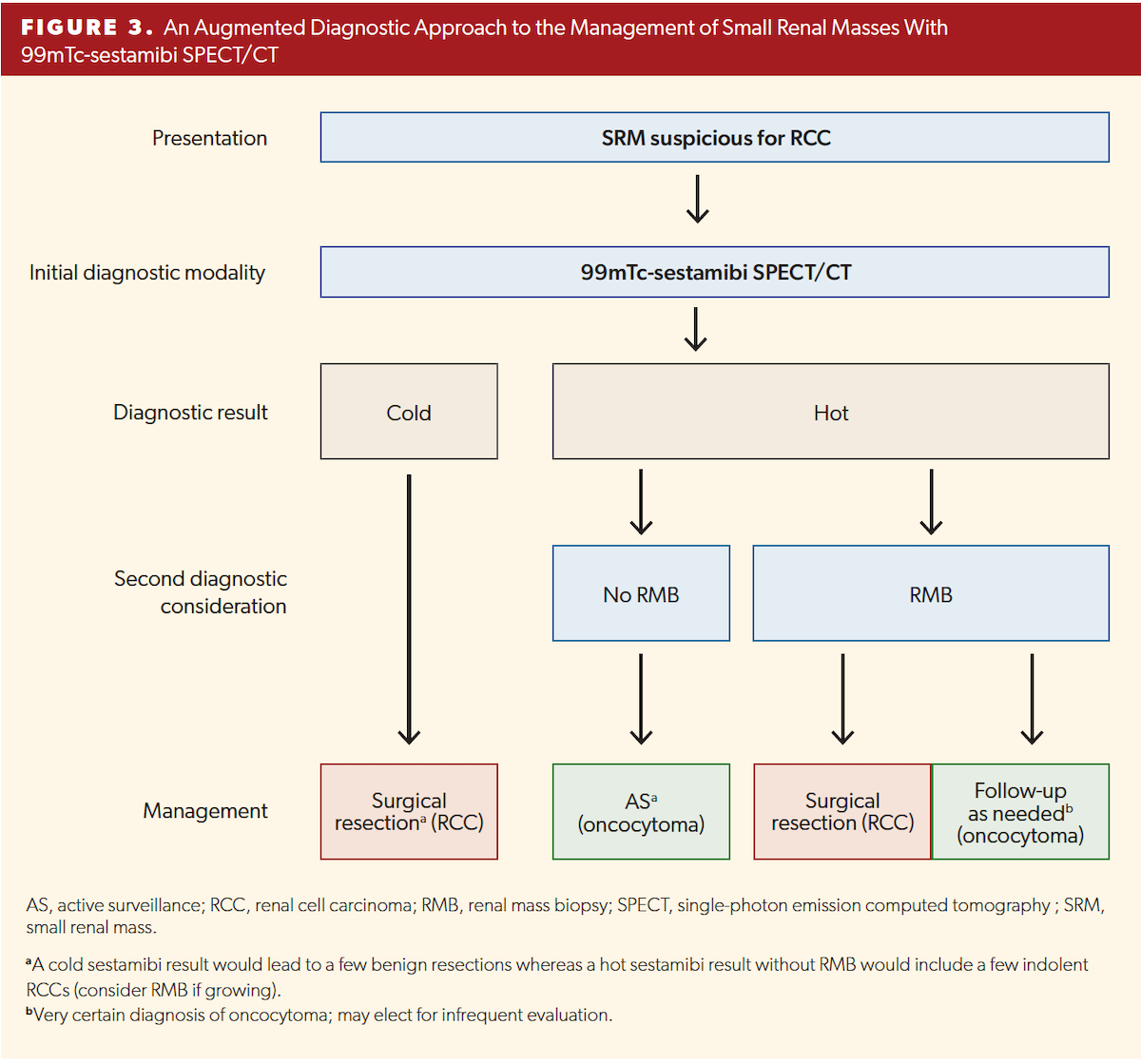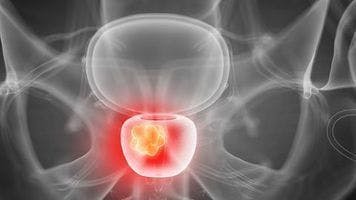Publication
Article
Urology Times Journal
Distinguishing between malignant and benign renal masses
Author(s):
"Augmented biopsy-based and noninvasive options are available to reduce benign resection rates of renal tumors with the consideration of PEER and 99mTc-sestamibi SPECT/CT," writes Hiten D. Patel, MD, MPH.
Benign renal mass resections
Approximately 3300 benign and 5400 low-risk cT1a renal masses are resected annually in the United States.1 The difficulty in distinguishing between malignant and benign renal masses has led to partial or radical nephrectomy, a major operation with implications for postoperative complications or renal dysfunction, being referred to as a surgical biopsy. Although smaller tumor size and female sex are associated with the presence of benign histology, clinical factors alone have poor discrimination to separate malignant from benign tumors. Additionally, 12% of tumors 4 to 6 cm in diameter and 7% over 6 cm may be benign.1 Renal mass biopsy is the primary traditional diagnostic modality to confirm tumor histology for management decisions (Figure 1).

With appropriate patient selection, cT1a tumors can be followed safely on active surveillance with triggers for delayed intervention without the use of biopsy for most patients.2 Patients comfortable with active surveillance without a biopsy or those with significant comorbidities or limited life expectancy may not need further testing if it would not affect the treatment decision. Additional diagnostic testing can be considered when a tumor grows significantly. However, most patients who receive a diagnosis of a renal mass are treated surgically where an accurate benign diagnosis could have changed the treatment plan.
Renal mass biopsy carries notable nondiagnostic rates (10%-15%) and a potentially low negative predictive value (NPV) around 70%.3 Although a positive result of cancer is accurate, the negative result of a benign tumor is constrained by the conundrum of the oncocytic neoplasm on biopsy. The nondiagnostic rate and NPV of renal mass biopsy have traditionally divided urologists into 2 camps: those who prefer to perform biopsies for nearly all patients and those who prefer to perform biopsies sparingly.4 One approach errs toward benign resections to ensure all malignant tumors are managed, whereas the other presumes benign results on biopsy are accurate enough to avoid surgery despite some level of uncertainty. However, we now have augmented approaches that can satisfy either camp while potentially reducing benign resection rates to near 0%. Therefore, wherever you fall on the biopsy spectrum, an augmented approach is ready for you to consider employing in practice by either measuring peak early-phase enhancement ratio (PEER) or using 99mTc-sestamibi single-photon emission computed tomography (SPECT)/CT.5,6
Biopsy-based approach with PEER
For urologists who prefer a biopsy-based diagnostic approach, the potential for a nondiagnostic biopsy in 10% to 15% of cases needs to be considered and anticipated. The issue is most relevant for smaller masses, but it is notable that every centimeter increase in size, even among the cT1a subset, is associated with a 3-fold greater probability of attaining a diagnostic result.7 For tumors with unfavorable location for biopsy, the 99mTc-sestamibi SPECT/CT approach described in the next section may be preferable from the start to reduce the chance of attaining a nondiagnostic result.
The traditional options for a nondiagnostic biopsy result include repeat biopsy, active surveillance, or resection. Of patients with nondiagnostic biopsies undergoing resection in the literature, approximately 90% have malignant tumors on surgical pathology.3 Therefore, intervention for most patients favoring it may be preferred in the case of a nondiagnostic result unless the patient has an imperative indication to undergo a repeat biopsy or consider 99mTc-sestamibi SPECT/CT.
For patients with a diagnostic biopsy result where renal cell carcinoma (RCC) is clearly diagnosed, the positive predictive value (PPV) is greater than 99%, and the result is essentially always reliable. Subtype concordance between biopsy and surgical pathology is also high, although approximately 16% of patients upgrade from low grade on biopsy to high grade after surgery.3
For patients with a diagnostic biopsy result that is negative, the finding is usually that of an oncocytic neoplasm consistent with oncocytoma. However, given that the NPV of renal mass biopsy is approximately 70%, this means 30% of patients may still have renal cell carcinoma.3,8 This is where CD117 (c-kit) status and PEER come into play to better classify patient conditions and raise the NPV (Figure 2). Oncocytomas and chromophobe RCC are often both positive for CD117 on immunohistochemistry. PEER is calculated by dividing the net enhancement of the tumor by the net enhancement of the cortex. For patients with CD117-positive status on biopsy, prior studies suggest a PEER value greater than 0.55 should be 100% accurate in differentiating oncocytomas from chromophobe RCC.5,9

Although 2 prior studies were based on a total of 53 CD117-positive tumors, we have an unpublished study of 58 CD117-positive tumors that confirms the high accuracy of PEER is reproducible across several raters. These initial studies are based on surgical pathology, but the results are convincing enough to believe CD117 status can be evaluated from a diagnostic biopsy result. Additionally, patients who attain CD117-unknown or CD117-negative results appear to largely follow the same rule if histology strongly suggests a diagnosis in the oncocytic to chromophobe spectrum, although performance may be reduced. PEER would not be applicable for patients ineligible for a contrast-enhanced CT scan or positive biopsy results where RCC is suspected because both papillary and clear cell RCC would be CD117 negative and could have high PEER values. Anecdotally, we have found a similar separation of oncocytomas from chromophobe RCC may be observed on contrast-enhanced MRI.
99mTc-sestamibi SPECT/CT with limited biopsy
For providers and patients who prefer a less-invasive option without biopsy, 99mTc-sestamibi SPECT/CT could be used up front.6 The scan takes advantage of the fact that the lipophilic cation 99mTc-sestamibi accumulates in mitochondria-rich cells such as the oncocytic cells of renal oncocytomas. In the present discussion, it may be best to frame a cold scan as a positive result, suggesting a malignant tumor, and a hot scan as a negative result, suggesting a benign tumor. Pooled results across 4 studies suggest a cold scan has a PPV of 95.2% (80/84) to identify RCC, with few benign oncocytomas or hybrid tumors being resected.10 Additionally, the NPV is 87.9% (29/33). This means a hot scan to identify benign tumors may be better than renal mass biopsy, which has an NPV of approximately 70%.3,10

Therefore, 99mTc-sestamibi SPECT/CT could be interpreted as a noninvasive biopsy, with cold tumors recommended for management and hot tumors either surveyed or biopsied for double confirmation (Figure 3). We have shown that 99mTc-sestamibi SPECT/CT followed by confirmatory biopsy for hot tumors is a cost-effective option that can avoid surgery for most benign tumors, use biopsy more sparingly, and minimize unmanaged malignant tumors.11
For individuals favoring a biopsy-free approach, another provocative but unstudied option could be to use PEER in conjunction with 99mTc-sestamibi SPECT/CT. Although most benign tumors will be oncocytoma, some benign RCC tumors may be chromophobe RCC, where PEER could distinguish them based on a low PEER value. Although this does not account for all potential hot RCC cases, it would at least further bolster the NPV of 99mTc-sestamibi SPECT/CT without the use of biopsy by using benign tumors as a rough, imaging-based estimate for CD117-positive status.
Conclusion
Augmented biopsy-based and noninvasive options are available to reduce benign resection rates of renal tumors with the consideration of PEER and 99mTc-sestamibi SPECT/CT. Although these approaches may be most useful for cT1a renal mass enriched with benign pathology, larger masses may still harbor benign histology where a benign diagnosis could prevent an imminent need for dialysis or unnecessary intervention for a poor surgical candidate. Emerging approaches in the future could include augmenting biopsy with a gene expression classifier.12 Ideally, trials comparing multiple modalities concurrently would provide the highest level of evidence in this space. The argument going forward will now be less about the accuracy of diagnosis and more about cost-effectiveness considerations and convenience of diagnostic modalities.
References
1. Patel HD, Semerjian A, Gupta M, et al. Surgical removal of renal tumors with low metastatic potential based on clinical radiographic size: a systematic review of the literature. Urol Oncol. 2019;37(8):519-524. doi:10.1016/j.urolonc.2019.05.013
2. Alam R, Patel HD, Osumah T, et al. Comparative effectiveness of management options for patients with small renal masses: a prospective cohort study. BJU Int. 2019;123(1):42-50. doi:10.1111/bju.14490
3. Patel HD, Johnson MH, Pierorazio PM, et al. Diagnostic accuracy and risks of biopsy in the diagnosis of a renal mass suspicious for localized renal cell carcinoma: systematic review of the literature. J Urol. 2016;195(5):1340-1347. doi:10.1016/j.juro.2015.11.029
4. Patel AK, Lane BR, Chintalapati P, et al. Utilization of renal mass biopsy for T1 renal lesions across Michigan: results from MUSIC-KIDNEY, a statewide quality improvement collaborative. Eur Urol Open Sci. 2021;30:37-43. doi:10.1016/j.euros.2021.06.004
5. Amin J, Xu B, Badkhshan S, et al. Identification and validation of radiographic enhancement for reliable differentiation of CD117(+) benign renal oncocytoma and chromophobe renal cell carcinoma. Clin Cancer Res. 2018;24(16):3898-3907. doi:10.1158/1078-0432.CCR-18-0252
6. Gorin MA, Rowe SP, Baras AS, et al. Prospective evaluation of (99m)Tc-sestamibi SPECT/CT for the diagnosis of renal oncocytomas and hybrid oncocytic/chromophobe tumors. Eur Urol. 2016;69(3):413-416. doi:10.1016/j.eururo.2015.08.056
7. Leveridge MJ, Finelli A, Kachura JR, et al. Outcomes of small renal mass needle core biopsy, nondiagnostic percutaneous biopsy, and the role of repeat biopsy. Eur Urol. 2011;60(3):578-584. doi:10.1016/j.eururo.2011.06.021
8. Patel HD, Druskin SC, Rowe SP, Pierorazio PM, Gorin MA, Allaf ME. Surgical histopathology for suspected oncocytoma on renal mass biopsy: a systematic review and meta-analysis. BJU Int. 2017;119(5):661-666. doi:10.1111/bju.13763
9. Kahn AE, Lomax SJ, Bajalia EM, Ball CT, Thiel DD. Utility of the aortic-lesion-attenuation-difference (ALAD) and peak early-phase enhancement ratio (PEER) to differentiate benign from malignant renal masses. Can J Urol. 2020;27(4):10278-10284
10. Wilson MP, Katlariwala P, Murad MH, Abele J, McInnes MDF, Low G. Diagnostic accuracy of 99mTc-sestamibi SPECT/CT for detecting renal oncocytomas and other benign renal lesions: a systematic review and meta-analysis. Abdom Radiol (NY). 2020;45(8):2532-2541. doi:10.1007/s00261-020-02469-8
11. Su ZT, Patel HD, Huang MM, et al. Cost-effectiveness analysis of 99mTc-sestamibi SPECT/CT to guide management of small renal masses. Eur Urol Focus. 2021;7(4):827-834. doi:10.1016/j.euf.2020.02.010
12. McGillivray PD, Ueno D, Pooli A, et al. Distinguishing benign renal tumors with an oncocytic gene expression (ONEX) classifier. Eur Urol. 2021;79(1):107-111. doi:10.1016/j.eururo.2020.09.017
























